 Churches of Christ & Christian Churches in the Pacific Northwest LANE COUNTY, OREGON West of I-5 except Eugene. |
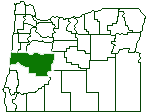
October 9, 2009 |
Alvadore | Antioch | Clear Lake Church | Coast Fork | Coburg
Cottage Grove | Elmira | Fairview | Fir Grove | Franklin | Grand Prairie
Hadleyville | Irving | Junction City | Lancaster | Latham | Long Tom
Lorane | Oak Hill | Spencer Creek | Thurston | Walton
Next Chapter . . . Pioneer Menu . . . Search - - Oldest presented first.
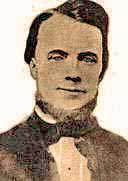 |
Alexander Vance McCarty made the following report to the Chistian Record:
In July, I held a meeting on Long Tom in Lane County and five additions were obtained to the good cause. The congregations there numbers about 25; they organized last spring on about 12 members. . . ."Grand Prairie
Gospel Meetings:
About 9 out of 10 additions were
by immersion, the rest were by
transfer from another congregation.1853 Alexander McCarty 5 added 1855 Levi Burch 8 added At the close of my effort, a young man who was a Methodist exhorter and class leader, came forward, made the good confession, and was immediately buried with the Lord in baptism. The cause of the Bible is rapidly advancing in this territory. It is already more influential than any other religious cause. May the Lord grant it success in time to come!
Christian Record, October 1853, page 124.
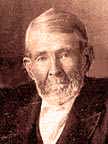 |
,
James A. and Elizabeth Bushnell united with this congregation in 1855. Helen Adkins was a sister of Mr. Bushnell. Visiting preachers included Gilmore Callison, John A. Powell, John Rigdon, John E. Murphy and Joseph H. Sharp.
The booklet Past is Prologue to the Future, published by the Oregon Disciples, carries this added information about the Grand Prairie Church: "During the Civil War, the church split over divided loyalties to the North and the South." The booklet indicates the Civil War issue was a factor in the establishment of the Junction City Christian Church.
|
Early members included: Edward & Helen Adkins, Allen Watson & Rachael Gross Bond, Allen & Rachael Robinson Bond, Helen J. Bond, Isaac William and Hettie McClure Bond, Vincent Scott & Etta McConnell Bond, J. W. Bond, Joseph Wolfe & Mattie Zumwalt Bond, Robert Bruce & Belle Gibson Bond, V. S. Bond, William Loretto Bond, James A. & Elizabeth Bushnell, Elizabeth Greene, A. R. Hobbs, George Hobbs, C. T. Jennings, J. C. Jennings, James F. & Nancy Bruce McClure, Vincent Scott & Sally Bruce McClure, C. A. Nott, J. H. Nott, John & Hetty Amanda Bond Parker, Lou E. Bond Robertson, Rufus & Louisa Elizabeth Bond Robertson, G. L. Smith, M. A. Smith, Clara F. Bond Spencer, Halvor & Eliza Catherine Bond Wheeler, William L. & Emma Jane Bond Wheeler, and Charlie and Mary Ellen Bond Withrow. |
The Grand Prairie Church slowly dissolved into several groups more convenient to their constituents.
In 1879 a part of the congregation that was coming to Grand Prairie from the west and south and had to cross the Long Tom River, moved into the Clear Lake School House and later built nearby, adopting the name Clear Lake Church. The building was just south of the school which we assume was near the intersection with Clear Lake Road on Green Hill Drive.
Organized by Peter Rogers Burnett, those members living the other direction, near Junction City, established a separate congregation under the leadership of James Bushnell, brother of Helen Adkins. William B. Barger and his wife Elizabeth Mulkey Barger were charter members.
Irving Mapquest
This entry is out of sequence so we can show that some of the people from the old Clear Lake Church moved toward Eugene and settled in the Irving district, near what is now Highway 99. In fact, they brought along their building.
An entry from the diary of Hetty McClure Bond reads:
Oct. 29, 1899The Yearbook of the Disciples for 1888 lists 80 members.
The Brothers, Sisters and friends met at Irving on Sunday, Oct. 29, 1899 to rededicate the Christian Church at that place, and raise funds to pay costs of moving the church to that place and repairs on the same all of which was raised by popular subscription. Preaching at 11 o'clock A.M. by D. C. Kellems at 2 o'clock by Morton Rose and at 7 P.M. by Dean E. C. Sanderson . . . ." (Spelling and punctuation of the original have been retained. The quotation is from the History of Irving Christian Church . . . 1853 - 1981.)
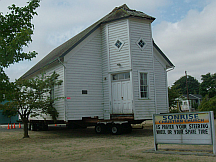
|
Thanks to Gary Haliski, we have a 2014 photo of the old building being moved to a newer location on the campus of the Nature Discovery Christian School. It is no longer used as a Christian Church.
 |
Like the Alvadore Christian Church, this congregation had its roots in the Grand Prairie Church. By 1880, the congregation was organized with 10 members as the Junction City Christian Church. James Addison Bushnell (overland in 1853) was one of the first elders. James and Elizabeth Adkins Bushnell were instrumental in founding the Eugene Divinity School (Northwest Christian College). One minister during that time was W. H. Wiltsee (or Wiltse).
During the late 1870's James Carr Campbell and his wife Mary Jane settled here while Mr. Campbell was principal of the Junction City High School. He was a nephew of Alexander Campbell.
A new church building was dedicated in 1892 during the ministry of A.D. Skaggs. It stood on the corner of 6th and Ivy. The church is now located at 1250 Nyssa.
The community of Coast Fork is gone from modern maps, but Lewis L. McArthur, writing in Oregon Geographics Names, knew of Coast Fork. The ancient town earned two pages in the history of the nearby Walker Community Church. A Wells Fargo stop and a post office were opened here in 1867. There was also a blacksmith shop, Howe's Trading Post and, in 1878, a stop for the Oregon-California Railroad Line. One historical source locates the town at 81618 Davidson Road. It was named for the body of water near it -- the Coast Fork of the Willamette River.
Christian Church historian C. F. Swander says the church began in 1863.
|
Special Gospel Meetings:
About 9 out of 10 additions were by immersion, the rest were by transfer from another congregation. | ||
| 1861 |
John Alkire Powell
Gilmore Callison Joseph H. Sharp |
42 added |
| 1869 | John M. Harris
John Burris Smith |
29 added |
| 1870 | John M. Harris | 2 added |
Dr. Jerry Rushford, writing in Christians on the Oregon Trail, says of this congregation,
The Coast Fork Church in Lane County was the site for an exciting ten-day meeting in October-November (1861) that resulted in 42 additions, including 31 immersions. John Alkire Powell, Gilmore Callison, and Joseph H. Sharp were the three evangelists who shared the preaching responsibilities.Another meeting is recorded in the August, 1869 issue of The Christian Record (page 367). It states:
"Brother John M. Harris, of Oregon, under date of May 20th, reports the result of a good meeting, held by him and Bro. J. B. Smith, on the Coast Fork of the Willamett river, 24 by immersion, 1 from the Baptists, 1 reclaimed, and 3 by letters - in all 29."The Township of Coast Fork remains and we can see it on the 1870 census. Nearly all of the residents are listed as farm families that year.
(Spelling retained from the source.)
Caleb Davis wrote to the Christian Record in 1869:
BROTHER J. M. MATHES: —I write to inform you and the readers of your valuable RECORD, that the cause of Christ is advancing in this "Far West." Bro. G. M. Whitney is our Evangelist for this county, (Lane). He and Brother Philip Mulkey are the only preachers we have in the county. Bro. Mulkey is doing all that a man of his advanced age can do, and is greatly beloved by all who are acquainted with him. He is laboring with good success.Its building was down the hill about 300 yards east of the Oak Hill Cemetery. This cemetery is just off Royal Avenue between Green Hill Road and Fir Butte Road. The present owner can remember an old "cabin" on the property. A church meeting house of that era would have met that description.Bro. Whitney is devoting his entire time to the ministry of the Word; having lost sight of every worldly interest, he is only intent in saving sinners and building up the Church. He has just closed a meeting at Oak Hill, of thirteen days' duration, with forty additions to the Church. This was a time of great rejoicing to all the brethren and sisters in this locality. This Church is near the residence of old Bro. Mulkey, and is the pride of his declining years. It is not quite two years since it was organized, and it now numbers 120, and is in a very prosperous condition.
Pioneer Reminder: Oak Hill Cemetery.
The Fairview congregation was organized in 1882 according to Swander. It met at the Fairview School on Poodle Creek north of Noti in the Coast Range. Members of the congregation were on the list of contributors to the new building to be built at Elmira. Baptisms were in Poodle Creek.
The church reported 19 members in 1892 and J. W. Horn was the contact person.
The Antioch Church of Christ came into being in 1884 according to church records and Levi Ellmaker of Oak Hill was one of the men instrumental in founding the congregation. A local historian, the late Loris Inman, suggested that Antioch was a daughter church of Oak Hill. Church met in the old Ellmaker School on Ellmaker Road near Highway 126. The building was a simple, pitched roof structure with a rough vertical board siding, two windows on each side and a door in front.
Pioneer Reminder: Ellmaker Road.
Fir Grove Mapquest
The Fir Grove congregation existed prior to 1891 because the church sent one delegate to the state convention in that year. Services were held in the Old Fir Grove School built of logs. The congregation later merged with the nearby Church of Christ at Elmira when it became clear that Elmira would be a town.
Pioneer Reminder: Fir Grove Lane.
Elmira Church of Christ Mapquest
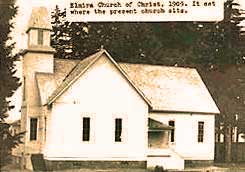
|
1909 Photo Courtesy of Violet Shafer |
Most of the names on the original handwritten list of contributors to the Elmira building were from one of these five congregations. In all, there were 34 families that combined funds to build the new building. The smallest contribution from a family was $1 and the largest was $50. For comparison, the itinerant preachers were paid $6 per Sunday.
| Early Ministers: | |
|
( S. M.? ) Martin W. T. Matlock E. W. Jordan |
1897 1899 1900 |
The congregation was officially formed January 6, 1896 and cast ballots for the following officers: Three elders, two deacons, two trustees and one clerk. The church opened on its very first day with an evangelistic meeting by A.D. Skaggs. Evidently they were taking full advantage of their new building.
During another evangelistic meeting held in 1900 by "Brother Lister," there were 27 added. (Lister is probably John B. Lister.) In 1904 in yet another evangelistic meeting, 47 were added.
| Special Gospel Meetings:
About 9 out of 10 additions were by immersion, the rest were by transfer from another congregation. | ||
|
1900
1904 1929 |
John B. Lister
? Olson Archie Word |
27 added
47 added 69 added |
Alvadore Christian Church Mapquest
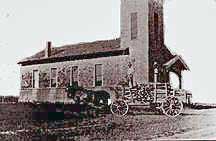
|
In 1915 they dismantled the Fern Ridge building and moved it to the newly platted town of Alvadore, named for Alvadore Welch, a railroad official. The building had been moved from Dallas by its former owners and now it was moving a second time - to the northwest corner of 8th and B streets. The church was renamed Alvadore Christian Church. After years of fund raising and volunteer construction work, in 1969 they moved into their current building.
Some of this information came from the pen of Richard Snider, local church historian.
Latham Mapquest (South of Cottage Grove.)
We have kept the previous congregations together in this presentation because they are related in development. Now we will step back to early pioneer years again. Henry Wells Taylor and Charlotte Taylor, natives of New Jersey, came overland in 1852 settling in the area near Latham, now about three miles south of Cottage Grove on Sixth Street. According to notes by descendent Lillian Taylor, the first meetings were in the log school house at Latham. The school dates from 1853 and public services were started in 1857.
Henry and Charlotte are buried in the very first plot at the entrance to the Taylor-Lane Cemetery south of Cottage Grove.
John Moses Harris (pioneer preacher of 1865) was also involved with the congregation, his name appearing on a list of donors to purchase books. He wife was Jane Harris. Perhaps some of these families moved south to form the Hebron congregation in later years. But the Latham congregation had life until the church was established further up 6th Street in the new town of Cottage Grove. Joseph H. Sharp operated a general merchandise store here. He will be discussed below with Cottage Grove.
John M. and Jane Harris are buried together in the Taylor-Lane Cemetery just off London Road.
Pioneer Reminders: Taylor Creek, Taylor Butte Road, Taylor-Lane Cemetery and the Latham School.
Spencer Creek Mapquest
This pioneer-age community had a post office during the 1870's. It was located southwest of Eugene, near the area where the Hadleyville church was later located. The church may have met in a home, but more likely a public meeting place such as the Grange or school house.
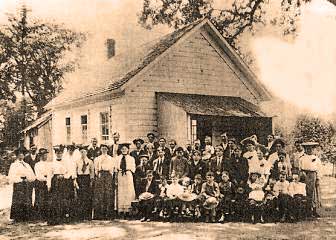
|
is very apt to be the Spencer Creek congregation. -- Photo:Lane County Museum |
The church is not listed in the comprehensive list of congregations published by the Christian Messenger in 1871. Because of its location near Eugene, we doubt that it was overlooked. So the origin of the group was sometime after 1871 and before 1877 when this report was filed in the "Reports from the Field" section of the Pacific Christian Messenger:
The "Bro. Mulkey" was probably Philip Mulkey who lived in the vicinity and was still active at that time. The author of the article was J. F. Amis, the preacher.Spencer Creek, Oregon
Bro. Stanley:
August 6, 1877
We had a good meeting at our place of worship yesterday. More than usual out, and better attention than common.Bro. Mulkey preached one of his plain practical Gospel sermons, at the close of which three precious souls --a young gentleman and two young ladies, made the good confession. Will be immersed on third Lord's day in August, in the waters of Cayota creek, above Conrad's store. Will have preaching and dinner on the grounds.
Fraternally yours,
J. F. A.
Lorane Mapquest (West of Cottage Grove.)
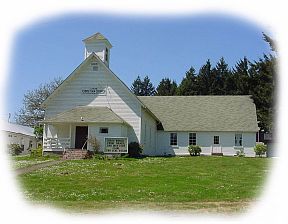
|
The Christian Church was established in 1889, and the building was constructed in 1892. Like many others, it died at some point and was resurrected, this time with strength to keep going. The building still stands, with sections added since the original construction.
Cottage Grove Mapquest
The Cottage Grove post office was at one time a moving target. It was established at the present site of Creswell in 1854, then moved to the present site of Saginaw in 1861 and finally four miles further south to its present location in the 1860s.
The Church of Christ was established in 1890. Our material is largely drawn from the church's own 100 year history Remembering Our Past to Strengthen Our Future, compiled by Joanne Skelton.
Services had been held for some time prior to the formal establishment of Cottage Grove as a town in 1887. Sometimes there were union services but in 1890 the Church of Christ built its own quarters and with minor exceptions, has occupied the same parcel of land since. The photo was taken in the early 1900's, but shows the original building.
An earlier church existed three miles south of Cottage Grove on Sixth Street in Latham. At the formation of the Cottage Grove Church, Joseph, Phebe, and Viola Sharp lived at Latham. Seven charter members, including the Sharp family were listed as from the "Old organization." While others transferring in were admitted with a "Letter from _____", these seven were not transferring from an existing congregation but were bringing the church with them.
Further corroboration is found in the Church Record book of the new Cottage Grove church. Its first entry begins on page 157 of the Record Book. Each page had printed across the top in a beautiful scroll type:

|
What was on the earlier 156 pages of the Cottage Grove Church Record? The book would not have been from the Hebron Church because it continued to exist and I.M. White transferred in from the Hebron church with a "Letter from Hebron." This group of seven had been attending somewhere and we believe that it was a now-forgotten church at Latham. They simply brought their old Church Record book up 6th Street when they started at Cottage Grove.
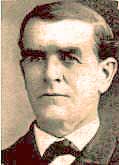
|
Ted Van Arsdol in Vancouver on the Columbia published by Windsor Publications.
| Special Gospel Meetings:
About 9 out of 10 additions were by immersion, the rest were by transfer from another congregation. | ||
|
1890
1894 |
A. D. Skaggs
A. J. Armstrong |
15 added
20 added |
Page 157 of the Church Record reports,
"Bro. A. D. Skaggs of Pleasant Hill, Oregon commenced a meeting at this place, Cottage Grove, on Monday December 15 - 1890 and continued to the 28 of Dec. and effected an organization with 50 members, 15 of (them?) were baptized by min. with Joseph H. Sharp, and Rufus G. Callison as Elders; and Oscar F. Knox and Chas. S. Smith, as Deacons."
How many present day churches would have a gospel meeting the last two weeks of December?
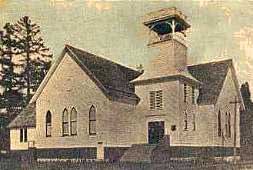
|
as it appeared in 1906 |
David Wetzel, then of Portland, preached at the church's opening day services and called for the retirement of the church debt. That was early in December of 1891. The money was given at that time, leaving the congregation free of building debt.
The early congregation had close ties with the Pleasant Hill Church of Christ. Darwin Bristow, Elijah Bristow's grandson and son of the Honorable William Wilshire Bristow, located in Cottage Grove and was a member of the congregation. The Callisons, mentioned below, were from Pleasant Hill. A. D. Skaggs was living at Pleasant Hill at the time he organized the Cottage Grove Church.
|
Among the overland pioneers starting the Cottage Grove Church in 1890 were Oscar P. and Sarah Cornwell Adams (1854), originally from Pennsylvania; Rufus G. and Martha Willis Callison (1852) from Illinois and Missouri respectively; Oscar F. and Sarah Churchill Knox (1853) from Schuyler County, Missouri and members of the McFarland family. James Henderson McFarland and Sophronia Knox McFarland both crossed the plains in 1853, but married in Oregon. Sophronia's younger sister, Laura Knox McFarland (1853) was married to James Henry McFarland but he is not listed among the founders of the Cottage Grove Church. Some of these folks had been members of the Hebron Church prior to moving to Cottage Grove.
|
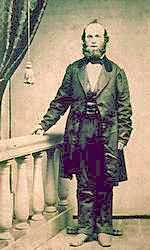
|
Photo courtesy of Clare Buhler |
J. H. Sharp was truly a pioneer preacher and had a clear view of the model of the New Testament Church. He worked full-time with the church until 1897. Both Joseph and Phebe are buried on the highest promontory of land in the Taylor-Lane Cemetery off London Road.
Hadleyville Mapquest
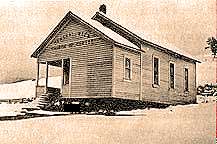
|
Courtesy of Marguariete Overholser |
The congregation was a capella and was called the Centralview Church of Christ. The earliest meeting place was the Hadleyville High School.
The church may have been established by John and Nancy Sutherland, evidently after they left New London. John and Nancy are buried there at the McCulloch Cemetery. Nancy lived with her daughter Emma C. Powell (Mrs. George A.) until her passing.
There is a profile of John Sutherland. More about John Sutherland is available in this Pioneer History by using our search engine. The McCulloch Cemetery is listed here.
Elaine Beebe attended church there in her childhood and was baptized across the highway in Coyote Creek. The building has been demolished, and only a person with a good memory like Elaine would be able to point out the location, just south of Hadleyville. Historian Clarence Swander lists the church as beginning in 1891. The deed to the property was recorded in 1910, so the building was built shortly after that year.
Walton Mapquest
This congregation on Highway 126 began in 1888 with the hard work of W. H. Wiltsee. He had established several other congregations in Lane County that same year. There were 21 charter members.
It is known that David Greene Gay and Charlotte Linder Gay were living in Walton in 1889. They may have been among the charter members. I. S. Day was an elder in 1895.
The Disciples Yearbook of 1892 lists 32 members with A.C. Barbour as the contact person.
By 1905, William and Irene (Callison) Marks were living there. Charlotte and Irene were granddaughters of Gilmore Callison. Wherever Callisons went in Oregon and Washington, a church was soon planted if it did not already exist.
There is a profile of Gilmore Callison.
The congregation built a building in the early 1930's and it was converted to use as a private home about 1976. The church does not meet now and people from that area attend the Noti congregation.
Franklin Christian Church Mapquest

|
|
|
In the spring of 1898 we succeeded in organizing a congregation of about forty-five members, mostly baptisms. The church now numbers sixty members. Last summer it became apparent we would have to build a house of worship for ourselves. We had been fortunate enough to secure D. C. Kellems, one of the best preachers in the State, to hold a two weeks meeting. (Charles Dailey: David C. Kellems was a teacher at the new Eugene Divinity School.)
Because of his fearless preaching of the Word, and the hard blows which he gave to sectarianism, he was given to understand by certain ones that that kind of doctrine didn't suit them. Bro. Kellems didn't care whether it did or not. He was not preaching to please men and rejoiced in the fact that he was not creed-bound.
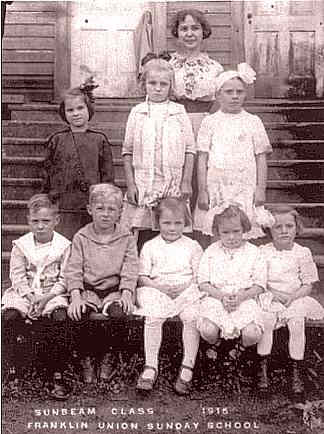
|
|
Eunice Allen, Tresa Smith and Thella Wooldridge; seated are George Smith, Earl Ivie, Melba Purkerson (or Pierkerson), Nina Bryant and Nellie Wooldridge. The preacher at this time was Arthur Charles Bates. Notice the damage caused by age on the right side of this original 1915 photo taken on the steps of the IOOF Hall. |
Last winter the congregation began worshiping in the school house in the village. It was decided to build a house of worship. We went to work. Money and material were subscribed freely. The church realized that the only way to build a church was to go to work and build it. They did so. This last spring work was begun and in a short time the building was ready to be dedicated to the worship of God. On the fifth Lord's Day in July the house was dedicated. Brother Kellems conducted the services. A large number of people were in attendance, about one-half being able to get into the house. At the close of the discourse an appeal was made to those who were willing to take their stand on the Bible and the Bible alone. Six came forward and united with the congregation, five being by letter and one by confession and obedience. Over $100 was raised to finish paying for the building. It was, therefore, dedicated free of debt.It is a beautiful structure and with the lot represents a value of nearly $700. It is very neat inside and outside and the brethren at Franklin are justly proud of it. It will seat about 200 people. In the new building we feel at home, and expect to do much work for the Master. We hope and pray that God will continue to bless his people there as well as elsewhere.
Marion and Nellie Horn are buried in the Inman Cemetery at Elmira.Historian C.F. Swander notes August, 1897 as the beginning date of the Franklin Christian Church, sometimes known as the Smithfield church because Daniel Smith sold them the property ($50). The Franklin name is from Franklin, Missouri. For many years, the preachers were students at Northwest Christian College in Eugene. It is located just south of the intersection of the Territorial Highway with the Applegate Trail. The congregation meets regularly.
Coburg Mapquest
A report in the Christian Standard of 1890 says, "I. N. Mulkey has been baptizing a number at Coburg lately." In the August issue, it was reported that I. N. Mulkey organized the church.
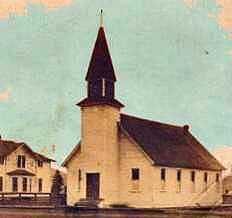
Coburg Christian Church Preacher George E. Williams wrote from here in 1910 saying that he was holding a gospel meeting and had 20 additions to the church and would close and begin at Sheridan on March 13th. From there he was scheduled to hold a meeting at Elmira, Oregon.
Thurston Mapquest
Clarence Swander pinpoints the beginning of the Thurston Church as April 6, 1890. This matches a report in the Christian Standard of April 12 that David C. Kellems held a meeting there with 33 additions by obedience and 11 others had been members before. However, the Lane County Historian reported:
The Thurston Church of Christ was organized in 1890 with 132 names on the first congregational roll. The land for the church was donated for $1 in 1893 by Martin and Martha Rees. Early baptisms were held in the slough at the end of Russell Road, now called 66th Street. The first pastor was D. C. Kellers (Kellems).Lancaster Mapquest
The earlier name for this farming village southwest of Harrisburg was Freedom. The post office was opened in 1858. A few years later, the name was changed to Lancaster. One story has it that Freedom was purchased by Johnson Mulkey from Philomath. He was Luke's brother, and changed the name of the town, the story goes. The problem is that Johnson Mulkey died before the supposed name change in 1866. Never-the-less, he was somehow involved in the early days of the town and the sawmill.
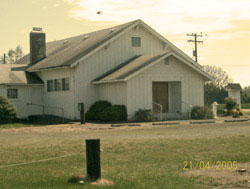
Lancaster Church of Christ Historian Swander says the congregation was launched in 1893. The present building shows signs of being built in the early 1900s. The church is a capella and has maintained its early values including emphasis on family life and the place of immersion is becoming a Christian.
The group prizes the great teaching hymns and includes them as a conscious part of their teaching.
Next Chapter: north Linn County or back to Pioneer Menu
To DOCHS 8/02
